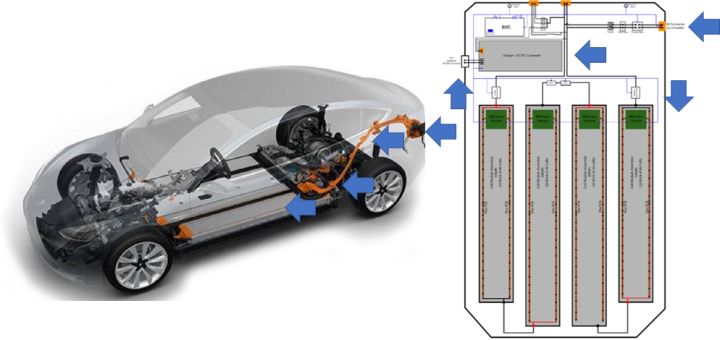For electric vehicles at this stage, increasing the cruising range to make long-range electric vehicles is the main development path. When the cost of batteries drops and the mileage reaches 500-600 kilometers after adding up, the main contradiction of electric vehicles transitions from mileage anxiety to charging anxiety. Improving the charging power of electric vehicles mainly includes several core elements. There are only two paths we can take:
Increase the current: If we keep the other components unchanged and choose the path to increase the current, the main limitation is the heat loss caused by the high current, which will cause the overall design to be very different. High currents in circuits generate high heat losses, as resistances of all components (connectors, cables, electrical connections to batteries, busbars, etc.) inevitably heat up. In the case of a battery that overheats during charging, these thermal losses need to be taken into account when designing and sizing conductive elements to avoid problems such as overloading, overheating, or controlled derating of the charging current.
Increase the voltage: Since the increase of the above current is limited, the current limit current is generally defined as 500A, and the power that can be achieved is about 200kW (Tesla designed more than 600A at 400V as an attempt), increase the voltage to put the 400V system Switching to 800V becomes an option. This is a systematic improvement for all electrical components. The core switching devices and other parts have changed. According to the current cost, these modules developed according to the 800V specification are relatively expensive. Taking the main inverter as an example, the cost of the core SiC module is about 4 times that of the original IGBT module.
Let's take a closer look at some of the issues that need to be considered in the paths that can be reached on both routes. Since several methods have the same requirements for the cell, we list the problem of the cell at the end, and focus on the electrical connection and thermal management inside.
The first path to upgrade on an existing 400V system
For most car companies, keeping the existing bus unchanged for a short period of time is a more realistic path. The higher the current, the larger the cross-sectional area of the cable required to transmit power at the same voltage level without overheating. This challenge will affect: the high voltage of the charging socket in the car, the charging socket to the battery pack Cables, fast charging contactors and main positive, main and negative contactors, main fuses, module wiring blocks, and internal wiring blocks of cells.
In this design, we have a more important problem, which is to design for a continuous and static current from 10s to 20 minutes. In the early design, since the current is fluctuating, although the peak point of the demand power of the entire drive is relatively high, the duration will only last for 10s and then decrease. The overall current can be done by using the rms root mean square design. In the design for DC fast charging, the process of power dissipation is heating on the wire, cable and contact resistance, and it changes with the increase in temperature during operation.
Remarks: In some life cycles, some areas with high impedance or limited heat dissipation may become the bottleneck of thermal management. If the heat cannot be fully dissipated, the heating process will not be affected by external influences. According to the existing mainstream design, the current testing is mainly around the design below 300A.
In our actual design consideration, the entire temperature connection point needs to be controlled below 100 degrees. The main reason is that exceeding one temperature will make the anti-corrosion coating of the conductor unstable. Similar to the problem of temperature rise caused by contact resistance and crimping resistance of charging cables and connectors below, it will also occur inside our above-mentioned batteries. If it appears at the battery connection, it will have a big impact on the battery.
Variation of the first path: Since under this path, we can also split the battery into two configurable systems of 400V*2.
In the short term: the configuration includes 400V high-voltage bus, 400V/12V DC/DC, 400V inverter, 400V air conditioner compressor, and 400V on-board charger.
The long-term approach is to process these two modules in series to form an 800V system. In my personal judgment, since the VDA-based module can also realize the conversion from 4P3S to 2P6S, if we build the entire battery system based on the VDA 355/390 module, the main method is to change the module configuration and the electrical connection in the battery system. . The parallel connection of two modules is at the expense of the current higher cost and higher energy consumption. This problem requires us to compromise and balance in the design.
There is a way to combine two batteries according to the conditions of external fast charging to form a configuration of voltage, which is divided into two battery modules A and B, both of which have a voltage of 400V. Under the conditions of discharge and AC charging, the two are connected in parallel. , the high-voltage DC bus is 400VDC; in the case of high-power charging, the two battery modules A and B are connected in series, the system voltage is 800VDC, and only the charging part is connected. Under fast charging conditions, the high-voltage electrical system is 800VDC, and the electric powertrain system under other conditions is 400VDC, basically maintaining the original structure. There is also a way to keep the batteries in parallel, similar to the Mercedes-Benz EQC, waiting for an opportunity.
The second path: 800V battery high voltage system
The battery system adopts 800V high voltage, and the electric powertrain system, including electric drive, power electronics, charging system, etc., also adopts 800V system. At present, this architecture can actually only be carried out on a limited number of vehicles, and major vehicle companies are currently evaluating the current progress. I personally think the main reason is that the current cost of SiC devices is too high, which increases the cost of all high-voltage electrical components such as inverters, DCDCs, on-board chargers, PTCs and electric compressors.
Most companies are evaluating the timetable for conversion on the main inverter, which is actually based on the expansion of the SiC material side, and further slowly evolves on the path of reducing the cost of semiconductor technology. At present, only the cost of 400V-based SiC devices used by Tesla is relatively affordable, and only a pure electric sports car with a high price such as Porsche can absorb this cost.
Summary: The window period for the development of the fast charging system is only about 2 years. It is necessary to wait for the domestic fast charging network to be established. After the cruising range is relatively stable at 500-600 kilometers in the next stage, the technical comparison is the fast charging power. The comparison above is the user experience of use.

















